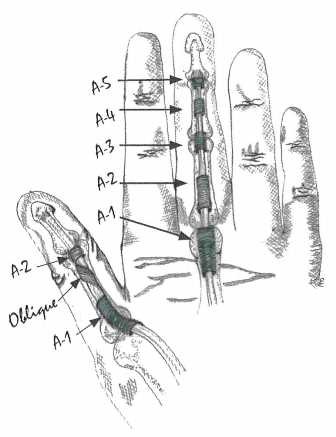
Trigger Finger: Not for Target Practice
2 CommentsAs we age, a little morning stiffness in the fingers may be a typical start to the day and opening and closing the fingers can quickly restore normal motion. When this stiffness causes a finger to lock in a bent position when making a fist, it can be much more painful to extend finger and is a condition that may require additional medical attention.
Trigger finger, known medically as stenosing tenosynotivis, is a common hand orthopedic issue. The tale-tell locking or “triggering” is often, but not always, accompanied by pain when trying to straighten finger as well as tenderness at the metacarpal phalangeal (MP) joint of the digit. The localized tenderness is the A1 pulley, which becomes thickened due to a variety of reasons including aging; systemic disease, e.g. diabetes,; or less commonly, trauma. The hand pulley system acts as a guide for the flexor tendons, similar to eyelets on a fishing pole, that are present to keep these tendons flush with the bone. When the A1 pulley becomes thickened or inflamed, the flexor tendons have a more difficult time moving through the “eyelet” becoming locked, most often in the bent (flexed) position.
Graphic excerpted from Nebraska Hand and Shoulder Institute Website
If the finger does become locked in the flexed position and it is much less painful to use the non-affected hand to perform a gentle passive release into extension instead of actively “pulling through” the restriction. A follow up visit to a physician is strongly recommended to address the underlying problem.
Non-surgical treatment of trigger finger can include custom fabrication of an orthosis (splint) by a skilled hand therapist to ensure proper fit for each individual. There are different techniques for splinting, but all involve blocking one of the three joints of the hand, most commonly the MP joint, where the A1 pulley is located. The splint can be worn up to full time as long as the splint is not irritating the wearer. A common prescription is a duration of three to six weeks1.
A cortisone injection at the A1 pulley area has been shown to help with pain and to decrease locking1. This can be done in conjunction with fabrication of an orthosis. Gentle exercises that allow each tendon to glide through the pulley are beneficial in decreasing and eliminating the locking. A skilled hand therapist can also provides instruction on body mechanics and joint protection to decrease the locking in day-to-day life.
Surgical intervention includes a release of the A1 pulley. This release allows the tendons to pass through the MP joint area with increased space, lessening the chance for locking. Post-operative care in therapy includes ROM exercises, scar management, and strengthening. Return to normal function is expected.
- Bionka, MA, et al (2014). Multidisciplinary consensus guideline for managing trigger finger: Results from the European HANDGUIDE study. Physical Therapy. Vol 94: 1421-433.


2 Comments
Myn
What’s the purpose of splinting trigger finger–does non-use lead to healing? It feels like a lack of fluid in the joints. I’m 69 years old so I assume this is an aging issue that is coming up with a few fingers, but mainly my dominant thumb. It is not painful. Would some hand exercises be appropriate? Thanks.
Rose McAndrew
Thanks for your comment. Your description of “lack of fluid in the joints” could be arthritis, for which there is a high correlation between osteoarthritis and trigger finger. As with many tendon pathologies, decreasing the usage of the tendons helps decrease inflammation and promote healing. For you, because your hand is non-painful, exercise without immobilization might be beneficial. Each digit has two flexor tendons and moving the joints simultaneously often “triggers” the trigger finger. So holding two out of the three joints straight with the non-affected hand while moving the third joint is my recommendation.